How I take fine-art photographs of horses with this simple camera setup
Leading British equine photographer Emma Campbell uses a DSLR, a 24-70mm lens and natural light for her tender portraits
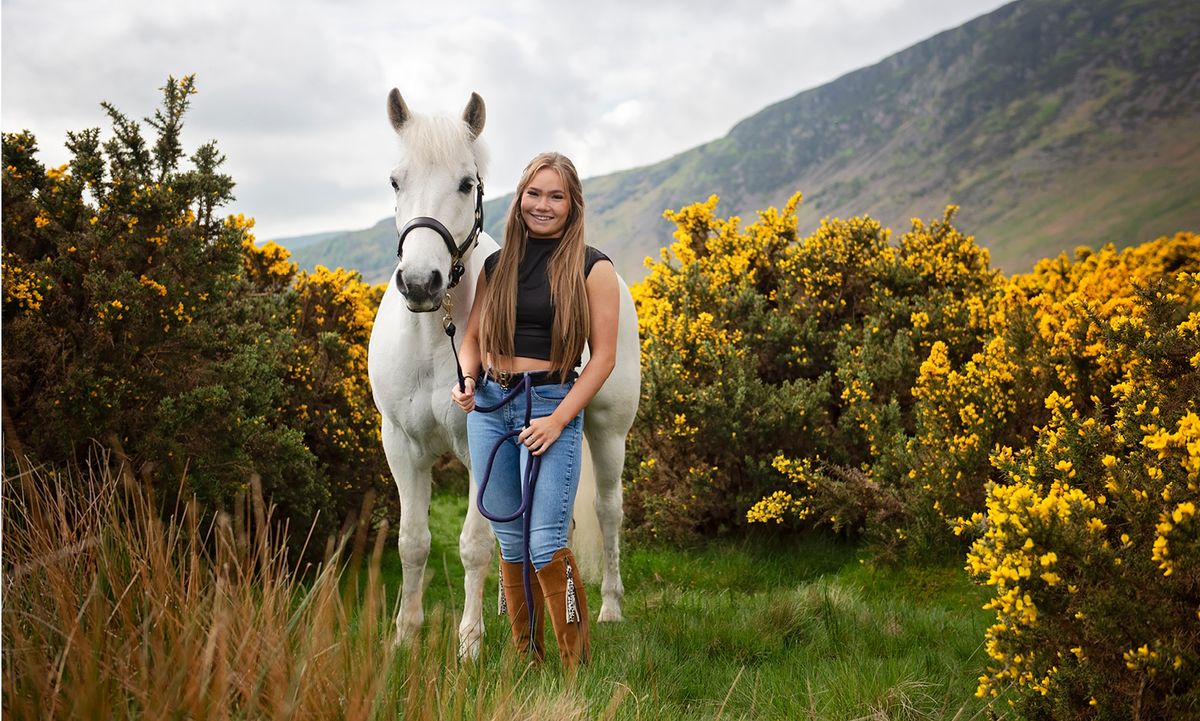
Emma Campbell shoots fine-art equine portraiture, capturing the special relationship that horses and their owners have.
The end product of her shoots is a high-quality print that clients can put on their walls, and Campbell’s catchment area takes in the south of Scotland, the north of England and the Midlands.
She likes to keep things simple on shoots: a full-frame DSLR, two zoom lenses and natural light. She doesn’t use accessories like reflectors or flash, as they can scare the horses.
We joined her for a portfolio shoot at Caldbeck Common in Cumbria, Campbell’s models for the day are Flip and Connie, accompanied by Connie’s mum Debbie.
Flip is an Irish Connemara and a handsome one at that; his white coat is in immaculate condition and his body language relaxed.

We start off with Connie and Flip on the road that bisects Caldbeck Common. Connie walks Flip 50 yards or so away, stops and turns around.
The weather conditions are overcast but benign and we’re enjoying a break in the rain. In fact, the gaps in the thin clouds – nature’s softbox – are producing gorgeous intermittent soft lighting.
Campbell switches between standing and crouching shooting positions, gesturing to Connie what she wants her and Flip to do, keeping things moving and injecting energy into proceedings.
She tells me that she likes to rely on a small number of tried-and-tested shot variations, which offer consistent aesthetic results for her clients.
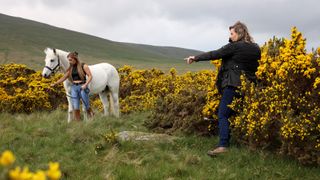
I ask where her affinity with horses comes from, as it’s clear she really knows how to get the best from the horse and its owner.
“My mum took me to the local riding school when I was eight years old,” she replies. “From then on I was hooked on horses and didn’t leave that yard until I was about 32.
“I did an equine science degree in the 1990s and it was there that I captured my first published photograph, which appeared in Horse and Hound magazine.
“Then I did a postgraduate course in newspaper journalism and worked part-time as a riding instructor and stable hand.
“A spell as a part-time cycling photographer and a wedding photographer followed on from that, and about eight years ago, after hearing a talk from commercial photographer Tim Wallace, I decided to go back to equine photography.”
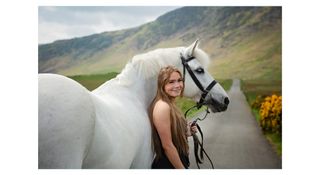
The physical and mental quick reflexes needed to shoot cycling and weddings have clearly put Campbell in good stead.
Her equine portraiture combines elements from both disciplines: being able to react instinctively to moving subjects – although she never uses burst mode, only single shot – and having an eye for capturing the tender moments shared by horse and rider.
For the next setup, Connie and Flip walk onto the common and pose in front of some gorse bushes. With the fell in the background and black, white, blue and brown across the scene, it’s a pleasing colour palette.
Campbell starts by dropping to knee height. With her models looking slightly down into the camera with strong eye contact for a pleasing hero shot, Flip and Connie’s chemistry comes across strongly.
Flip is behaving exactly as hoped for, thanks in no small part to Debbie, who stands behind Campbell waving her arms around to the sound of neighs produced by Neigh, an iOS smartphone app.
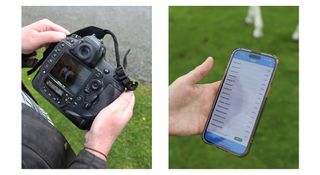
Cloud movement is causing occasional variations in the light levels but at least there are no harsh shadows.
Campbell tells me that her go-to settings start at f/3.5, with shutter speeds and ISO adjusted from that point. Using a DSLR, she can’t see how settings changes affect the scene so she relies on the viewfinder’s exposure level meter, aiming to stay in the middle.
I ask her what she does if Matrix mode (Evaluative on Canon bodies, Multi on Sony cameras) gets confused by the lightest and darkest extremes across today’s scenes: Flip’s white coat and Connie’s black top.
“I’m quite old fashioned and always work in Manual mode, using the exposure meter,” she replies.
“I can be more creative this way – I don’t want the camera telling me what to do. Sometimes, I go to the horse and meter from there, or I meter from Connie’s black top and then do a compare and contrast to see what the camera is giving me.
“I learned a lot from photographing black fell ponies in Cumbria – if the shots on the rear screen weren’t what I wanted, I would meter from the grass to see what the difference would be, take three photos and check if they were too light or too dark, then tweak my settings.”
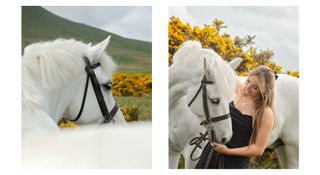
With this shot in the bag, Campbell sets up one of her most popular client photos – a tender portrait of the horse from the rear.
Prior to a shoot, Campbell always confirms with the owner that their horse is unlikely to kick out at someone behind them; having worked with Flip before, Campbell knows how mellow his behaviour usually is.
“This is a relaxed shot that picks up the curves of the horse, and it’s one I tend to do at the very end of a shoot,” she explains, adding that when editing shots like this, she will replace the background with a bespoke brown one.
After a few frames and a couple of variations, Campbell says she’s happy. Right on cue, spots of rain start to fall, but we’ve been very lucky with today’s horseplay.
Emma Campbell’s kit bag for equine portraits

1) Nikon D4
“I bought this full-frame DSLR about five years ago, having used a Nikon D750 before. The D4 is my workhorse.”
2) Nikkor AF-S 24-70mm f/2.8G ED
“The main lens used for shooting my equine portraits. The focal range gives me most focal lengths that I need on the day.”
3) Nikon D750
“Mainly used as a backup body since buying the D4, but the D4 is so reliable I don’t use the D750 very often.”
4) Sigma APO 70-200mm F2.8 EX DG OS HSM
“My other lens for equine photography – it gives me extra reach if I need it and the quality is good, too.”
5) Billingham Hadley Pro
“As my camera setup is so simple – two bodies and two lenses – I can just use this bag or a small photo backpack.”
6) Neigh smartphone app
“iOS smartphone app that produces many different horse noises, which helps put horses at ease during shoots.”
Emma Campbell’s tips for editing equine photos
“I started using Photoshop in 1999 and I have grown with it. It’s a program that I adored from the start – I never progressed to Lightroom because Photoshop offers me everything I need.”
“I always shoot in raw and process the files in Adobe Camera Raw. I try to keep my editing workflow for portraits as simple as possible, and use Photoshop Actions to speed things up.”
“On today’s shoot, I lost some highlights, which needed recovering, and Flip’s coat picked up some green from the grass near the gorse, which I had to tone down with a neutraliser.”
“I also do some cloning, if one of the reins is too close to the horse’s face, or to tidy up buckles. To do this, I zoom in to 300 or 400 per cent, so no errors are missed.”
“To tone down the brightness of the buckles, I use the pointer and the eyedropper tool to double-check on a selection of the buckle that’s a slightly darker colour. I swap to the brush tool at a low opacity and brush over extreme highlight areas.”
The importance of mentoring
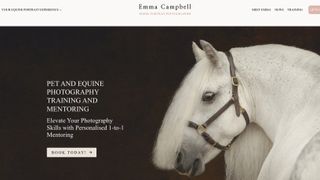
“Whether it’s for image editing or photography, get a mentor,” says Campbell. “I wouldn’t be creating the work I do now without the support of a mentor.
“They can provide a non-biased opinion and encourage your creativity. To find out more about mentoring, see the page on my website.”

A Guild of Photographers Master Craftsman, Emma Campbell is based in England’s Lake District and her photographic mission is to capture the unique bond between horses and their owners.
Emma Campbell: why photos should be printed
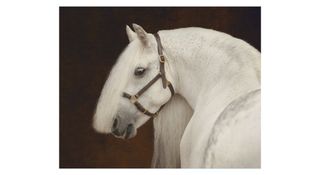
“While discussing a potential shoot with a client,” says Campbell, “we go back to why they want to do the shoot in the first place – to get a piece of wall art they can hang at home.
“It might be a young girl who has got her first pony and she has grown in confidence because of it – I want her to look at that portrait every day and know how amazing she is and what she’s achieved.
“I rarely give clients just digital files now, although they can have them if they want.
“However, producing a piece of wall art is more special and I can guarantee the high quality of the paper and the quality of the end product.
“Loxley Colour prints my wall art and 3XM makes my handcrafted folio boxes, which contain matte prints in different sizes,” she says.
Read more: This article first appeared in the July 2024 issue of Digital Camera magazine.
Subscribe today – all subscribers (print and digital) can access digital back issues dating from 2009 (when using iOS) or 2012 (when using the Pocketmags Magazine Newsstand app or the Pocketmags website).
Digital Camera World is the world’s favorite photography magazine and is packed with the latest news, reviews, tutorials, expert buying advice, tips and inspiring images. Plus, every issue comes with a selection of bonus gifts of interest to photographers of all abilities.
Get the Digital Camera World Newsletter
The best camera deals, reviews, product advice, and unmissable photography news, direct to your inbox!

Niall is the editor of Digital Camera Magazine, and has been shooting on interchangeable lens cameras for over 20 years, and on various point-and-shoot models for years before that.
Working alongside professional photographers for many years as a jobbing journalist gave Niall the curiosity to also start working on the other side of the lens. These days his favored shooting subjects include wildlife, travel and street photography, and he also enjoys dabbling with studio still life.
On the site you will see him writing photographer profiles, asking questions for Q&As and interviews, reporting on the latest and most noteworthy photography competitions, and sharing his knowledge on website building.
